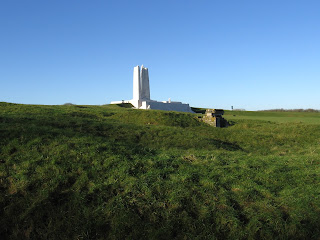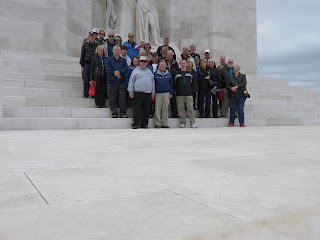
I took this photo in 2000. This spot is now occupied by a new French memorial to the war dead, but from NDL one can still see very clearly the advantages offered to the side holding the high ground. From the heights of Notre Dame de Lorette, one can see the Zouave Valley -- where much of the Canadian artillery was located, and Vimy Ridge in the distance.

Though I took this photo from NDL, from the top of Vimy Ridge the Germans could observe the Canadian positions all the way back to the divisional and corps headquarters. 1st Canadian Division HQ was near Mont St-Eloi, marked here by the ruins of the abbey church.

Before heading to the Vimy Ridge memorial park, we stopped at Cabaret Rouge, one of the Commonwealth cemeteries in the area with a large number of Canadian dead from the Vimy battle. Canada's unknown soldier, now lying at the national war memorial in Ottawa, was originally buried here at Cabaret Rouge.

There are two cemeteries in the memorial park itself. This is Canadian Cemetery No. 2, a short distance from Hill 145, whereupon sits the memorial.

At Canadian Cemetery No. 2, I found this row of headstones which perfectly illustrated something I had read long ago about the platoon commanders having some of the shortest life expectancies at the front. Here are seven lieutenants from the same battalion (the 75th, from the Toronto area, part of 11th Infantry Brigade in 4th Division) all killed on the first day of the Vimy battle, 9 April 1917.

The view of the memorial from Givenchy Road Cemetery, a short walk from Canadian No. 2. In the foreground you can see some of the Canadian trenches. This was 4th Division's front, and the memorial sits atop Hill 145 in the distance.
These rebuilt and preserved trenches at Vimy were part of the 3rd Division's front line. This was a string of outposts on the Canadian side of a line of large craters which formed no man's land in this sector at the start of the battle. The 7th Infantry Brigade used the Grange subway to move from the rear areas into these trenches, sheltered from German artillery. Today, you can tour the Grange subway, the exit of which is in the upper left part of the photo, right in front of the trenches.
The obligatory group shot at the memorial.

I took these next few photos in 2007 but it all looks the same today. Walter Allward won the Canadian government's design competition in 1921 but the memorial wasn't completed until 1936. Allward wouldn't be rushed and insisted on doing things properly, rejecting large quantities of stone -- which was quarried in Croatia -- that didn't meet his high standards for perfection. The product, in my humble opinion, is the most moving and striking memorial on all of the Western Front.

The front of the memorial overlooks the Douai Plain, which stretches out to the right of the photo. This is the German side of Hill 145, with the remains of a German bunker at right-centre.





























 ...and parties-in-your-mouth.
...and parties-in-your-mouth.


















